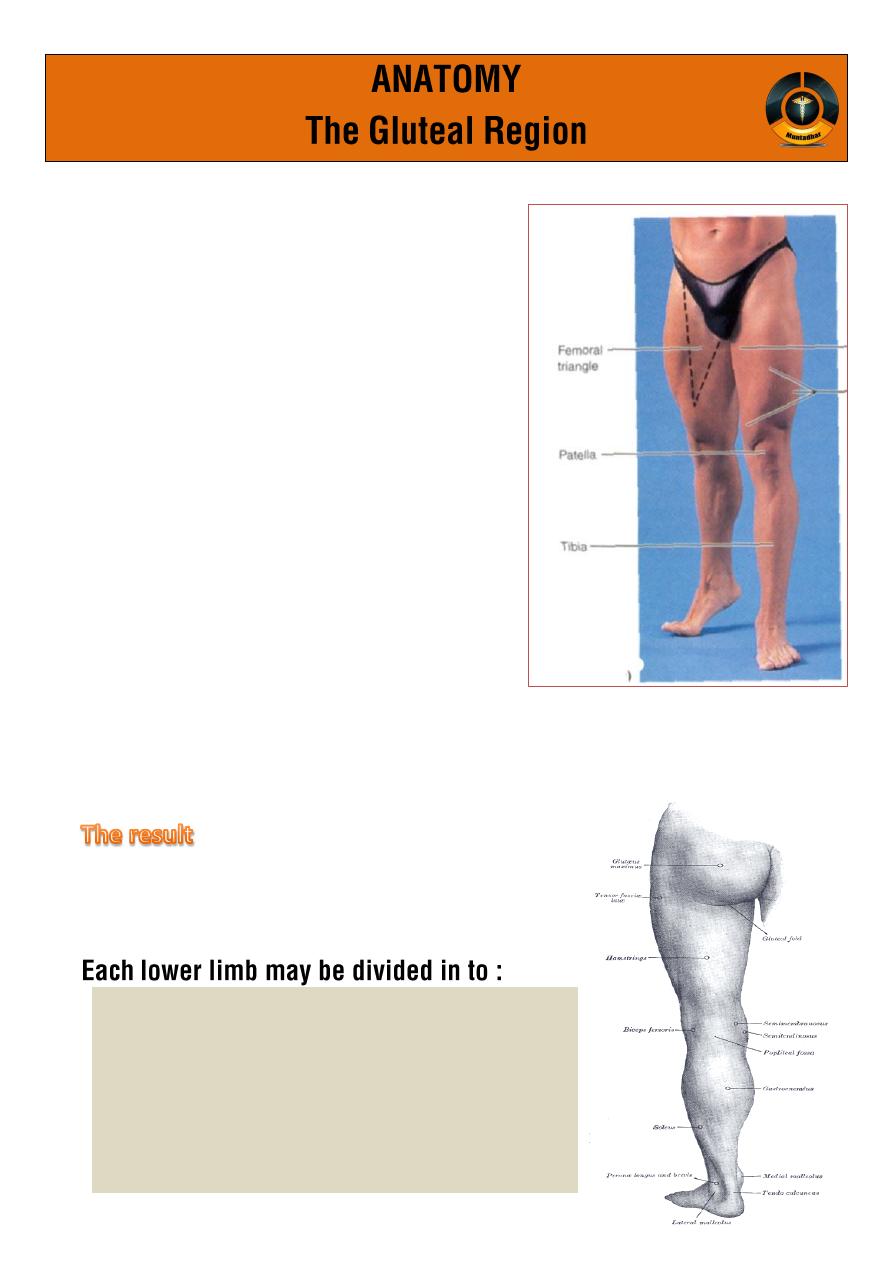
o The primary function of the lower limb
is to
support the weight of the body
&
to provide a stable foundation in
standing, walking & running.
o They have become specialized for
locomotion
.
o The lower limbs although similar in
structure in many aspect to the upper
limbs ,have
less freedom of movement.
o Where as the pectoral girdle of the
upper limb is united to the trunk by
only a small joint ,
the sternoclavicular
joint
, the two hip bones articulate
posteriorly with the trunk at
the strong sacroiliac joint & anteriorly
with each other at the symphysis pubis.
o
is that the lower limbs are
more
stable
&
can bear the weight of the body
during standing ,walking&running.
o
Gluteal region
Thigh
Knee
Leg
ankle
Foot
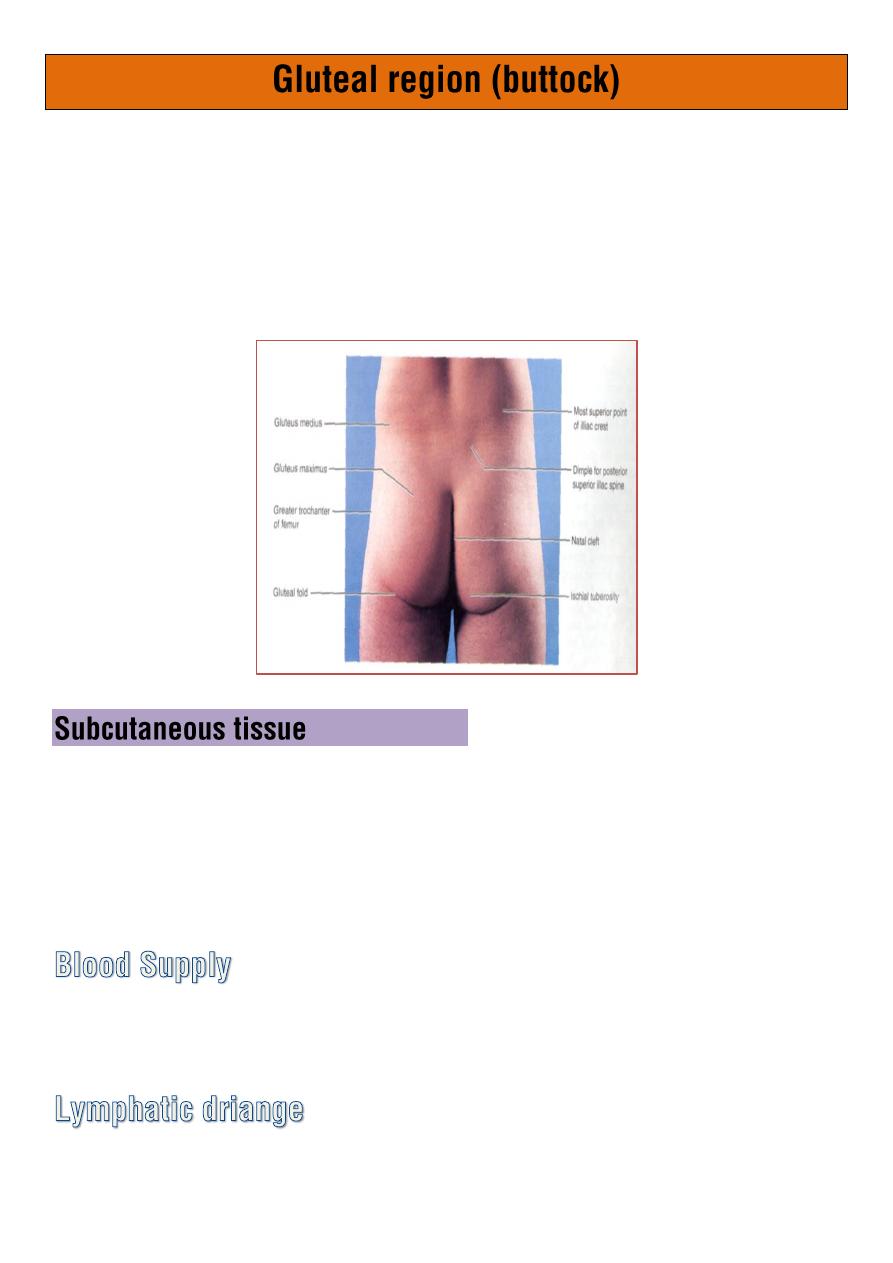
o Lies behind thepelvis , is bounded
superiorly by the iliac crest
&
inferiorly by the fold of the buttock.
o It is largely made up of the
gluteal muscles
and a
thick layer of
superficial fascia
which overlies the (muscles ,nerves & vessels)
which leaving the inside of the pelvis and passing to the lower limb.
o The
panniculus adiposus
is well developed in the gluteal region and
gives to the buttock its characteristic convexity.
o The
fold of the buttock
is the transverse skin crease for the
hip joint
& is not caused by the oblique lower border of the gluteus m.
o The blood supply of the skin & fat
: is derived from perforating
branches of the
superior & inferior gluteal arteries.
o Lymphatic driange : drain into
lat.group of the superficial inguinal
lymph node
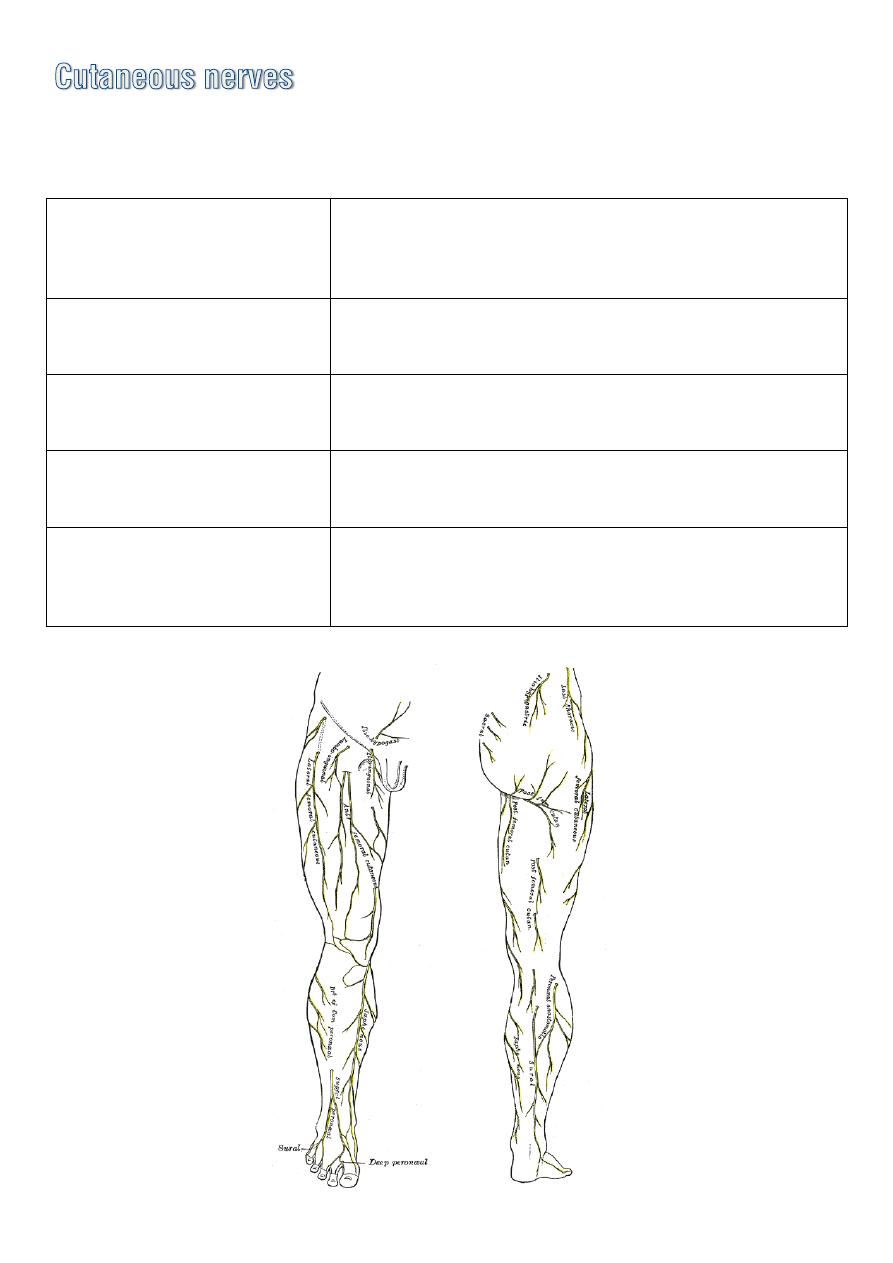
o are derived from
posterior & anterior rami
of spinal nerves as
follow:
Upper medial quadrant Post.rami of :
upper 3 lumbar Ns
upper 3 sacral Ns.
Lower medial quadrant post cut. N. of the thigh (S1,2,3 ant.rami)
Upper lateral quadrant lat.brach of iliohypogastric L1,T12
N.ant.rami.
Lower lateral quadrant lat. Cut. N. of the thigh. (L2,3 ant.rami)
The skin over the coccyx
in the floor of the natal
cleft
is supplied by small branches of the lower
Sacral & Coccygeal nerves.
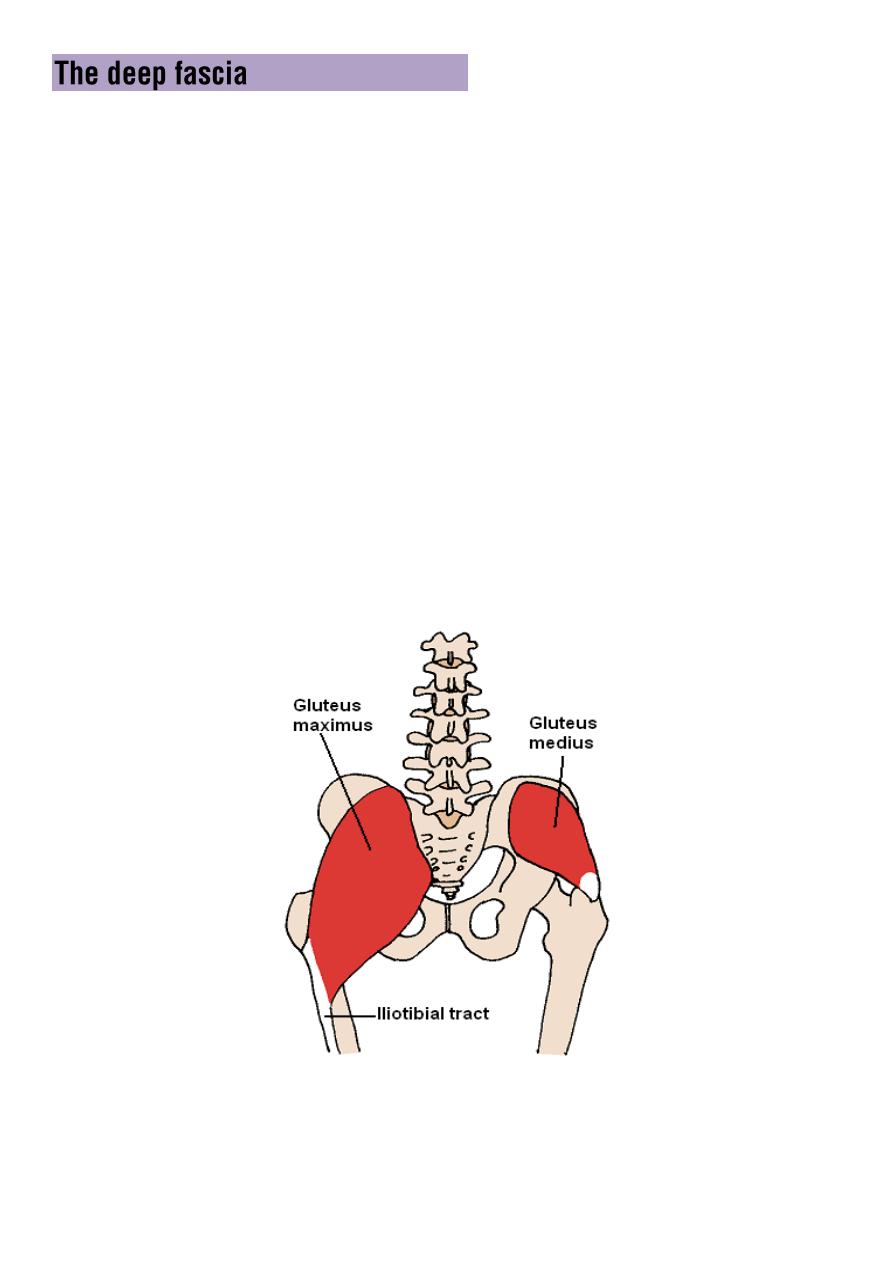
o Is continuous below with the
deep fascia or fascia lata of the thigh.
o In the gluteal region it
split
to enclose the
gluteus maximus m
.
o Above it continues as a
single layer
that cover the outer surface of
the
glut.med.
and is attached to the iliac crest.
o On the lat.surface of the thigh the fascia is thickened to form a
strong wide band the
iliotibial tract
.
o This is attached above to the tubercle of the
iliac crest
and below to
the
lateral condyle of the tibia
.
o The iliotibial tract form a sheath for the
tensor fascia lata m.
and
receive the
greater part of insertion of the gluteus maximus
.
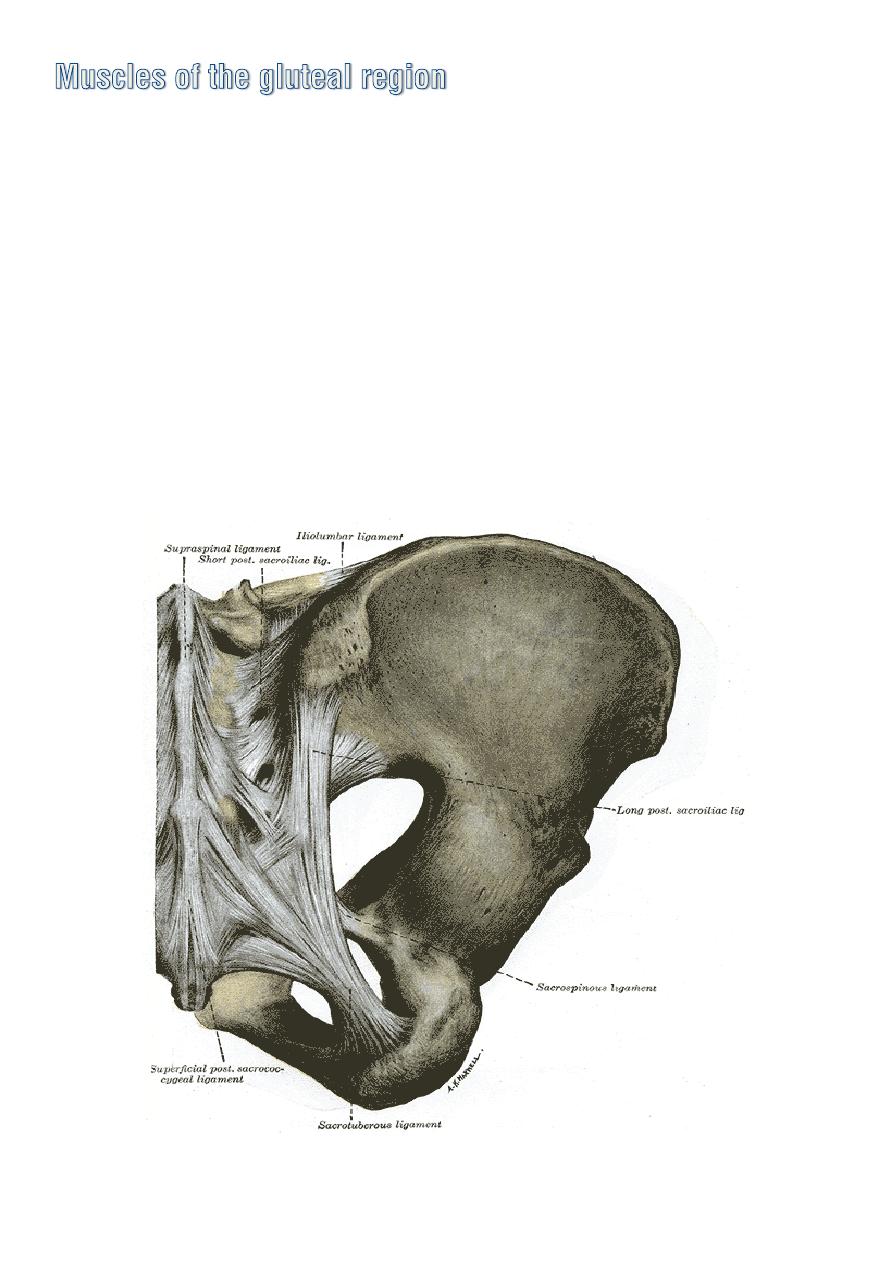
1- Gluteus maximus.
2- Gluteus medius.
3- Gluteus minimus.
4- Tensor fasciae latae.
5- (Short) lateral rotaters of the thigh at the hip joint
Piriformis
Gemellus superior
Gemellus inferior
Obturator internus
Quadratus femoris
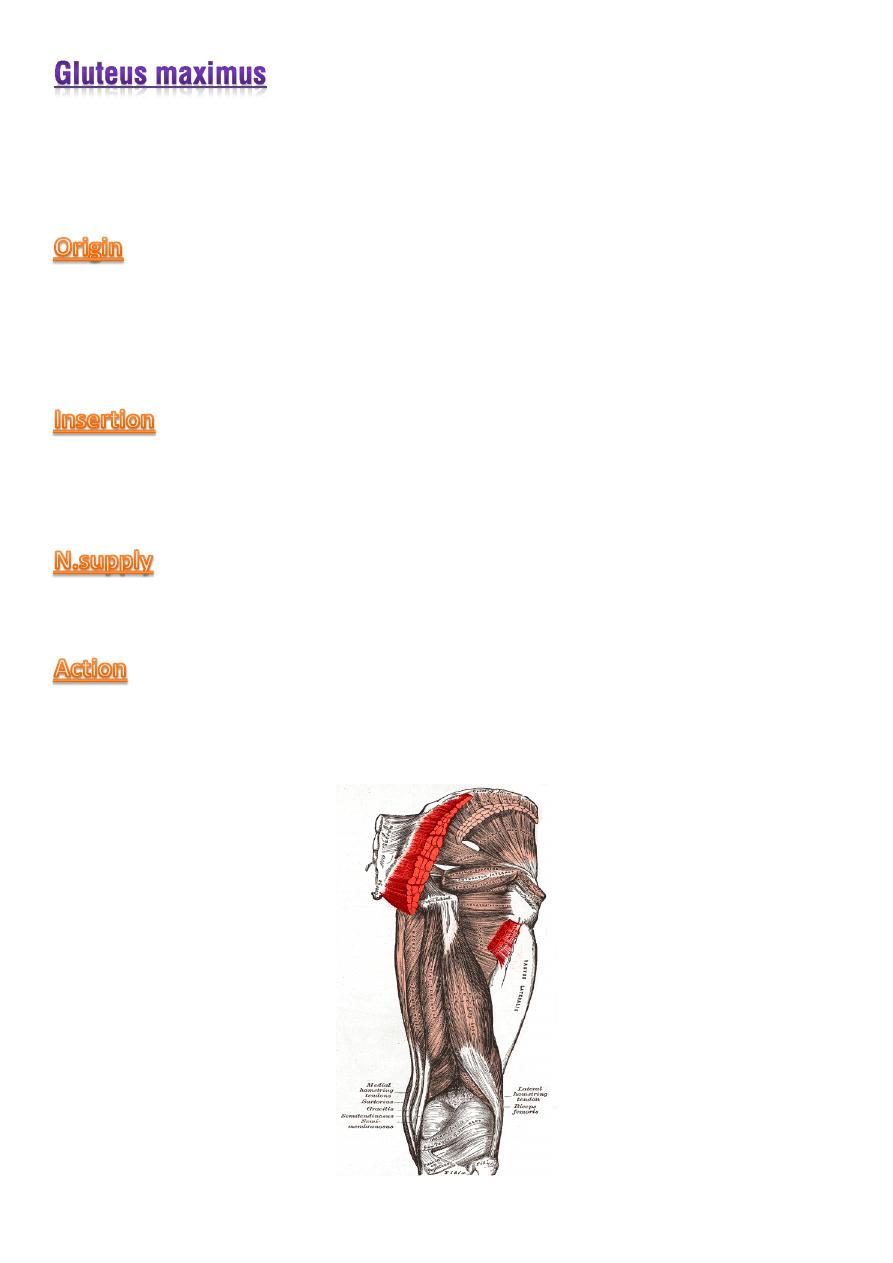
o Is the most superficial of the group.
o It is a large flat quadrilateral forming the prominence of the
buttock.
From an extensive area including :
the gluteal surface of the ilium behind the posterior gluteal line
the post. surface of the sacrum , coccyx & sacrotuberous ligament.
The fibers pass downward & laterally into the
iliotibial tract 3/4
and
the
gluteal tuberosity of the femur 1/4
rd
Inferior gluteal n.
1- it is a
powerful lateral rotater & extensor
of the hip joint.
2- acting through the iliotibial tract it
extend & stabilize the knee joint
.
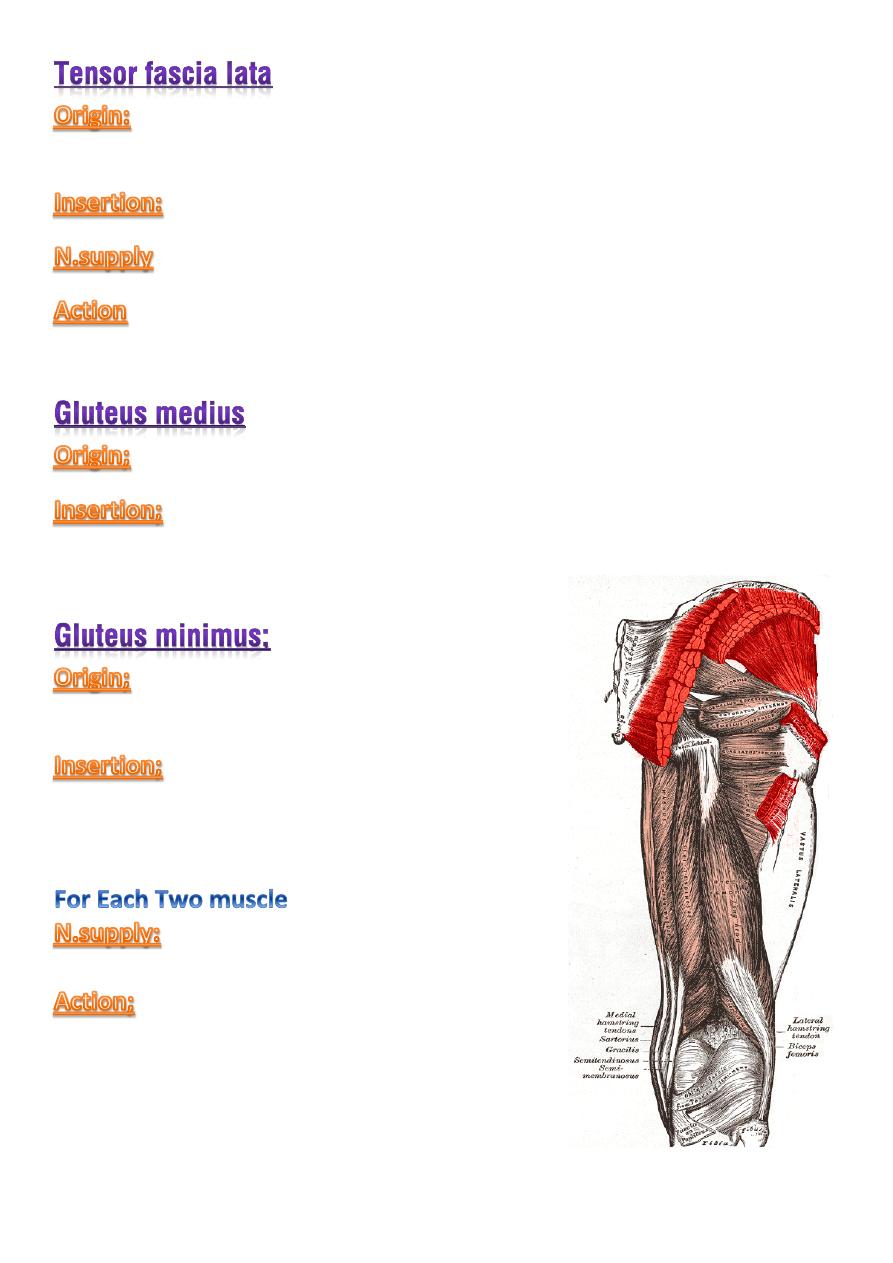
from the
outer edge of the iliac crest
between the ant.sup.iliac
spine & the iliac tubercle.
to the iliotibial tract.
: sup.gluteal n.
: extent & stabilise the knee joint.
gluteal surface of the ilium
between
middle & post.
gluteal line.
lateral surface of greater trochanter.
gluteal surface of the ilium
between
middle & inferior
gluteal line.
anterior border of the greater
trochanter.
sup.gluteal n.
o powerful abductors at the hip joint
o weak medial rotators at the hip.
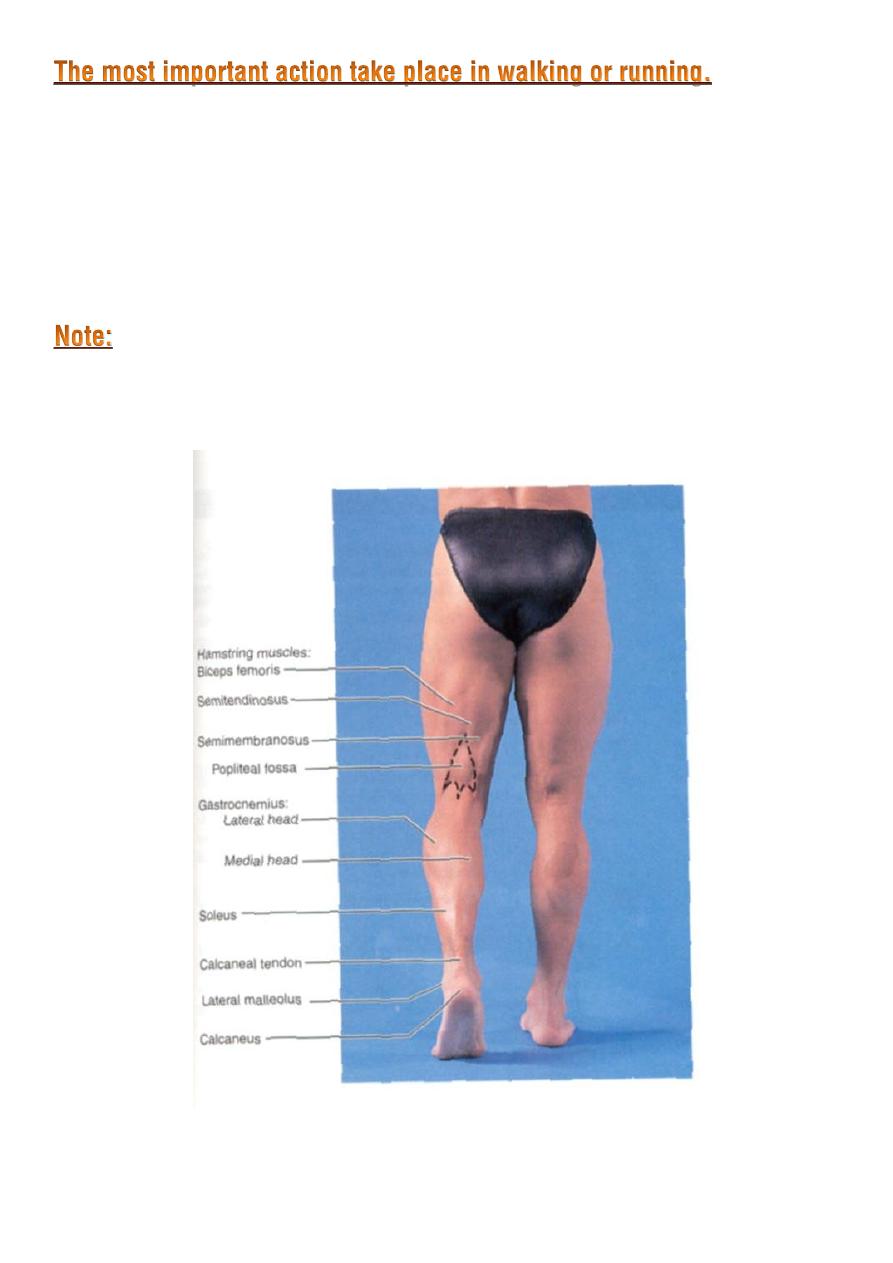
o The muscles contract and steady the pelvis on the lower limb.
o When the foot of the opposite side is taken off the ground and
thrust foreword , the pelvis is held in position and does not tilt
downward on the unsupported side.
The gluteus maximus lies behind the hip joint and overlies ; gluteal
muscles , short lateral rotaters of the hip and structures that passed
through the greater and lesser sciatic foramen.
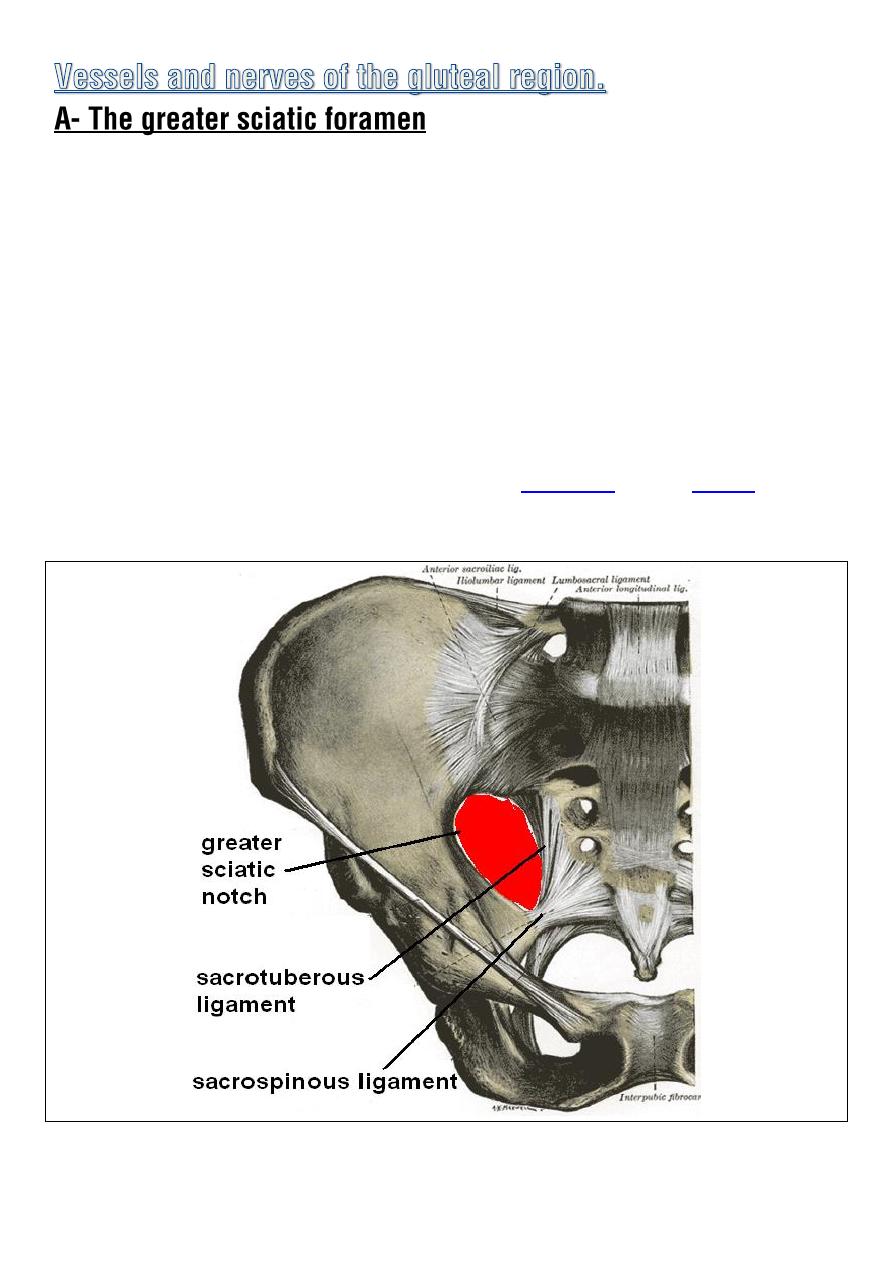
o is produced by the
sacro-spinous lig.
bridging the greater sciatic
notch in the hip bone.
o The foramen is the
only conduit between
the pelvic cavity and the
buttock.
o Number of structures emerge from the pelvis in to the gluteal
region above or below the piriformis muscle in the greater sciatic
foramen.
o The greater sciatic foramen is a major
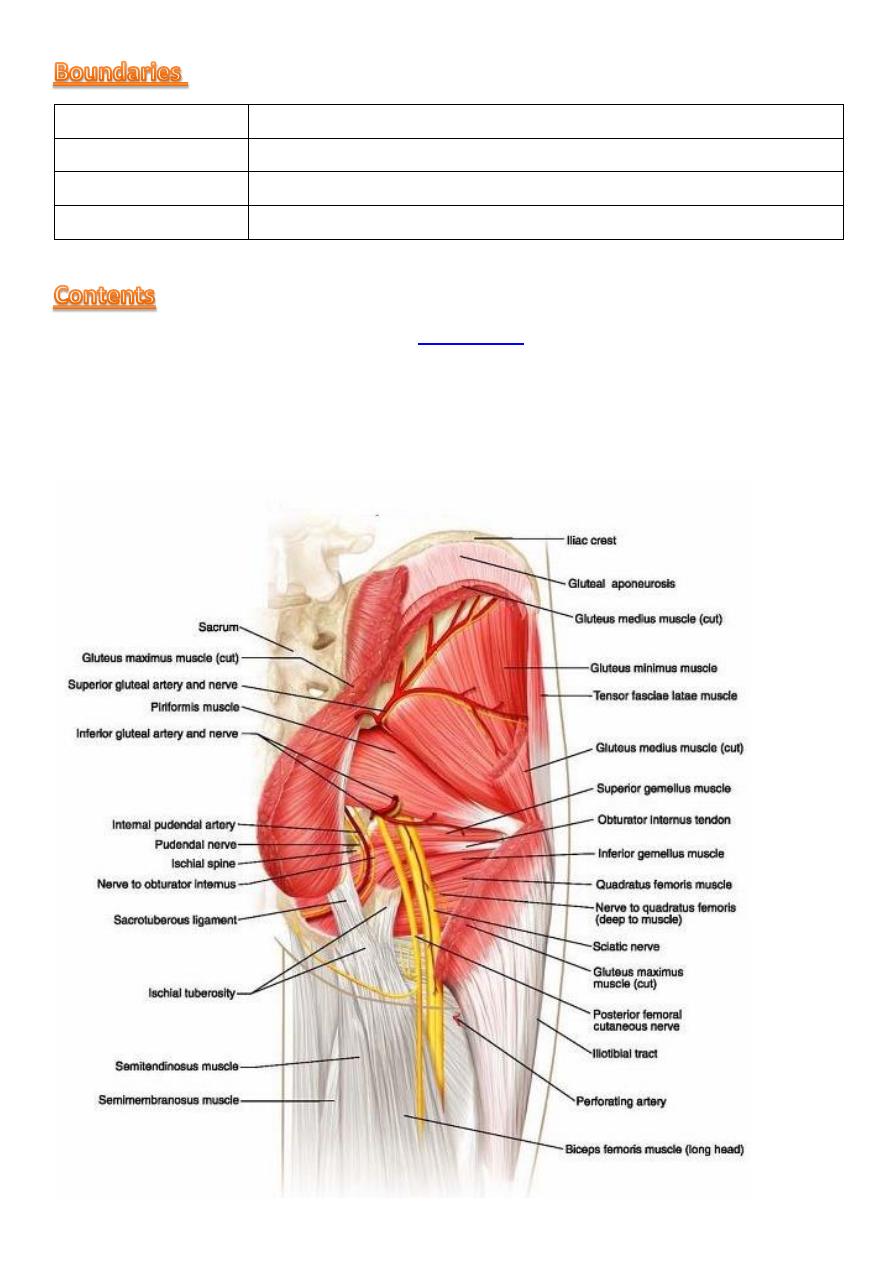
It is bounded as follows:
Anterolaterally the
Posteromedially the
Inferiorly
ischial spine
Superiorly
the
anterior sacroilliac ligament.
o It is partially filled up , by the
through it.
o The following structures make their exit from the pelvis through
the greater sciatic foramen.
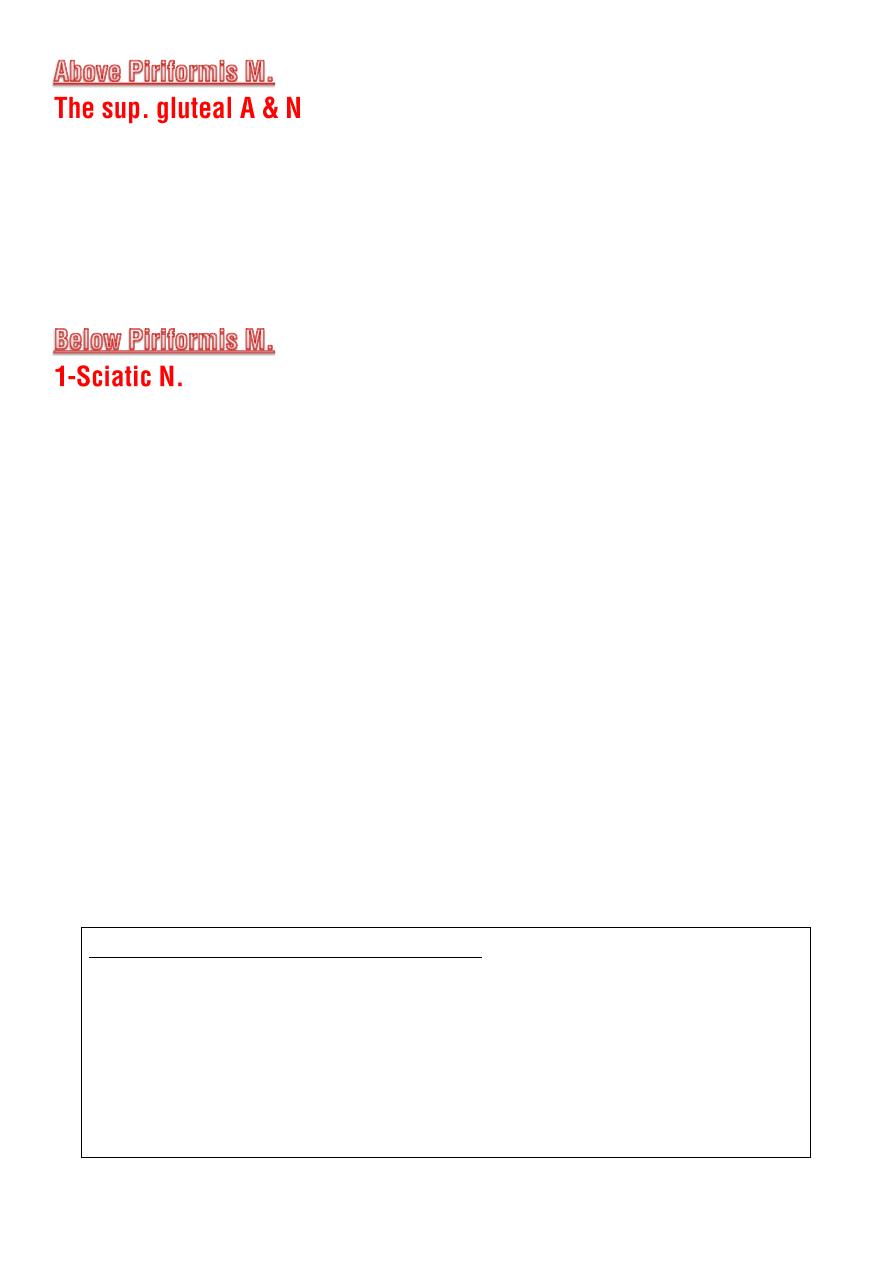
o pass upward and lateraly between
gluteus medius & minimus
o supplying these
muscles and tensor fascia lata.
o The artery takes part in the anastomosis around the hip.
o It is branch of internal iliac artery.
o It is the largest nerve in the body (L4,5.S1,2,3) .
o emerge
lateral
to the ischial spine and lies successively on
the root of the ischial spine ,
superior gemellus m. ,
obturater intrenus m. ,
inferior gemellus m. ,
quadratusfemoris m.
o To reach the back of the
adductor magnus.
o It is related posteriorly to the
post.cut.n.
of the thigh and the
gluteus maximus.
o It lies about mid-way between the ischial tuberosity and the
greater trochanter.
o It leaves the buttock region by
passing deep to the long head of
the biceps femoris
to enter the back of the thigh.
o
The sciatic n.gives no branches
in the gluteal region.
The nerve is sometimes injured by :
o penetrating wounds pelvis
o dislocation of the hip joint
o badly placed intramuscular injection in the gluteal region
The injection should be placed in the
upper outer quadrant
of
the buttock
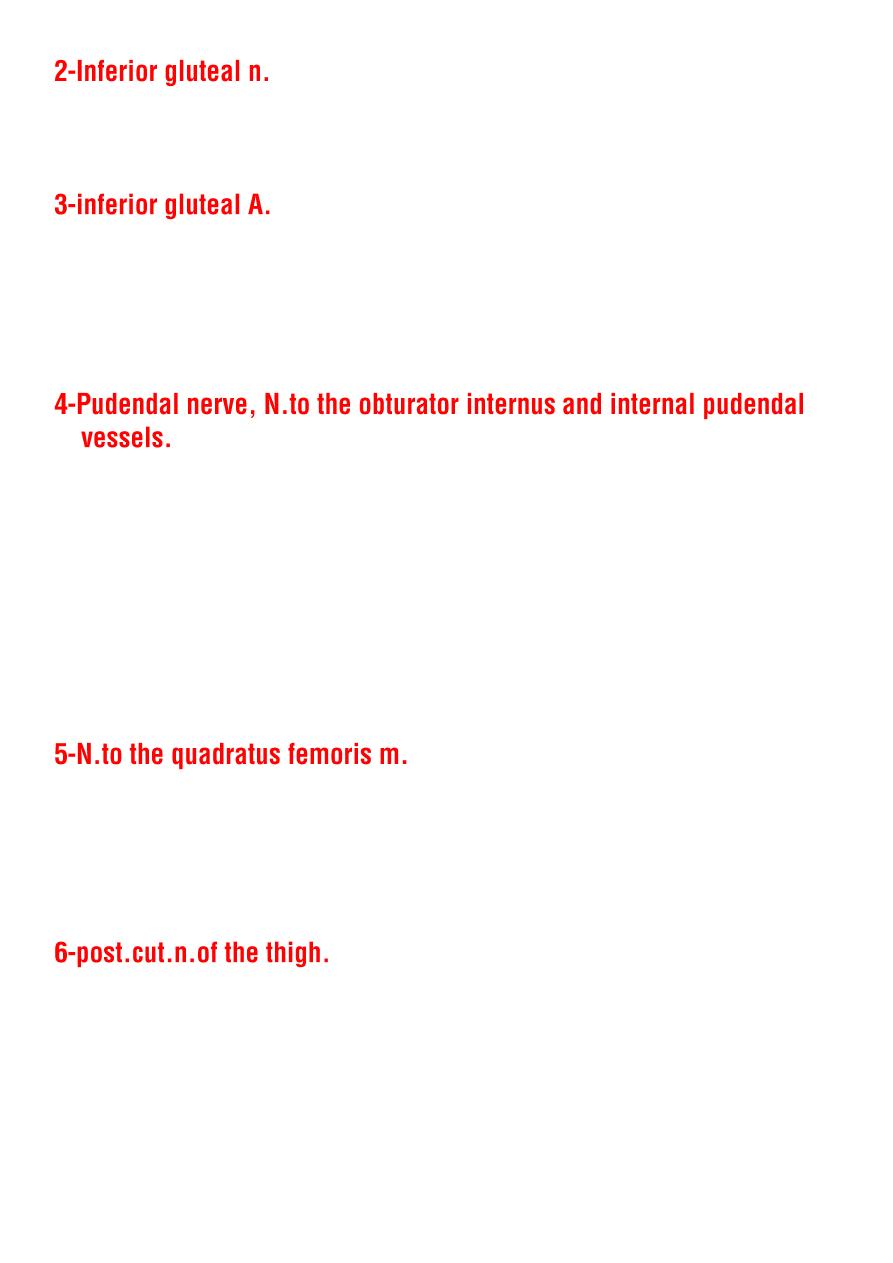
After a short course enter the
substance of gluteus maximus.
o Ramifies in the lower part of the buttock and take part in an
anastomosis around the hip joint.
o It is branch of internal iliac A.
o They cross the ischial spine and immediately re-enter the pelvis
through the lesser sciatic foramen , they then lie in the
ischiorectal fossa.
the pudendal N. supplies stractures in the perineum.
The N.to the obturater internus supplies the obturater internus
m.on its pelvic surface.
o A branch of the sacral plexus cross the root of the ischial spine
deep to the sciatic N.and the tendon of obturater internus .
o It supply qudratus femoris and inferior gemellus.
o Emerge superficial to the sciatic n.and descend in the midline of
the thigh beneath the deep fascia.
o it supplies the skin of the buttock , perineum and post.aspect of
the thigh.
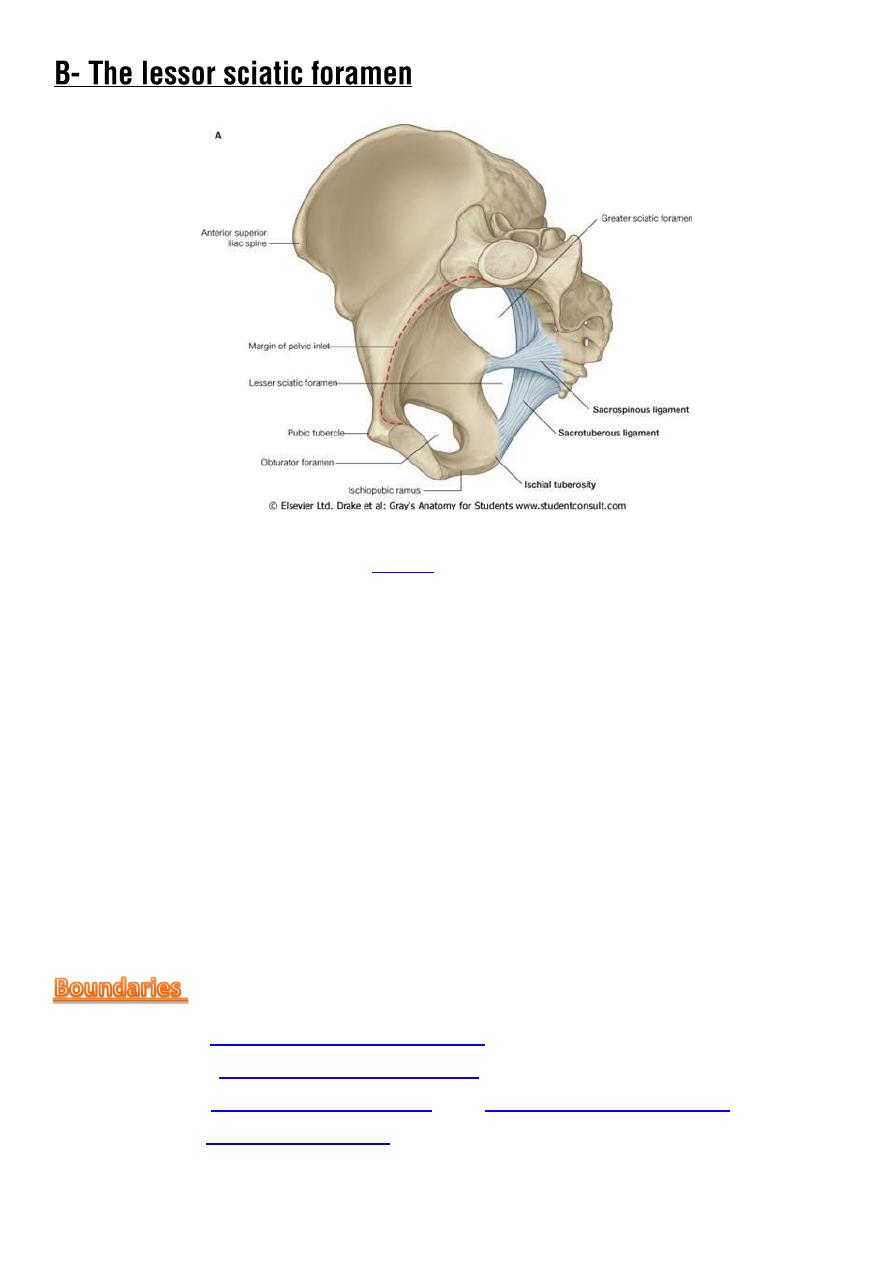
o An opening between the
o Lies between
Sacrotuberous and Sacrospinous ligament
o Is bounded
lateraly
by the
concave part of the ischium
that lies
between the ischial spine and ischial tuberosity.
o The
obturator internus m.
as it emerges from the
lateral wall
of the
pelvis, plugs the lateral part of the foramen.
o The
medial part
of the foramen form a
tunnel shaped orfice
which
leads foreward into
pudendal canal.
o The
internal pudendal vessels and nerve
enter the foramen from
the buttock and directed into the canal.
The lesser sciatic foramen has the following boundaries:
Anterior:
Posterior:
Superior:
laterally:
by
the concave part
of the ischium that lies between the
ischial spine and ischial tuberosity
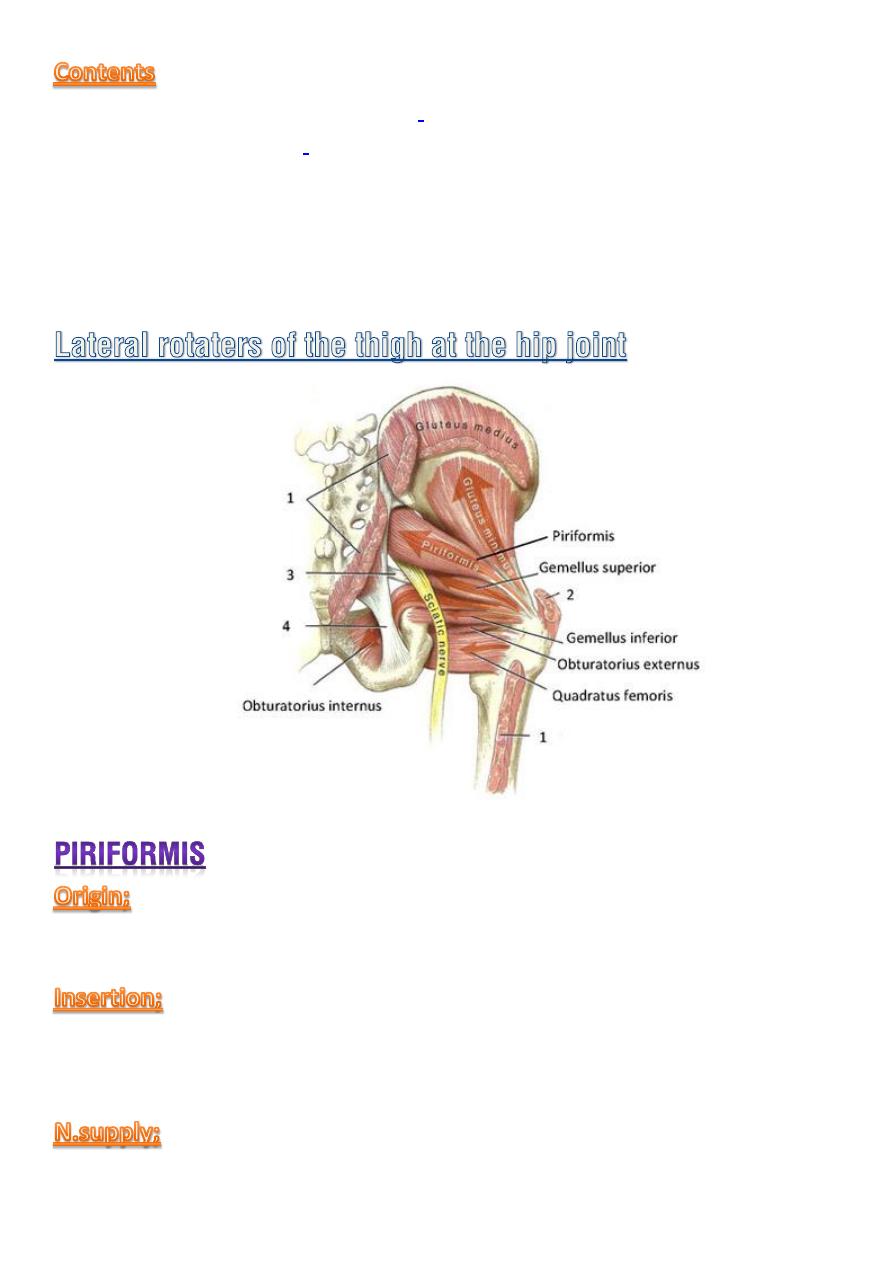
It transmits the following structures:
o the tendon of the Obturator
internus
o internal pudendal
o internal pudendal vein
o pudendal nerve
o nerve to the obturator internus
from the ant. Surface of the 2
nd
,3
rd
and 4
th
Sacral vertebrae
within the pelvis.
the fibers pass downward and laterally through the
greater
sciatic foramen
and are attached to the
upper border of the
greater trochanter.
ant. Rami of the 1
st
and 2
nd
Sacral nerves.
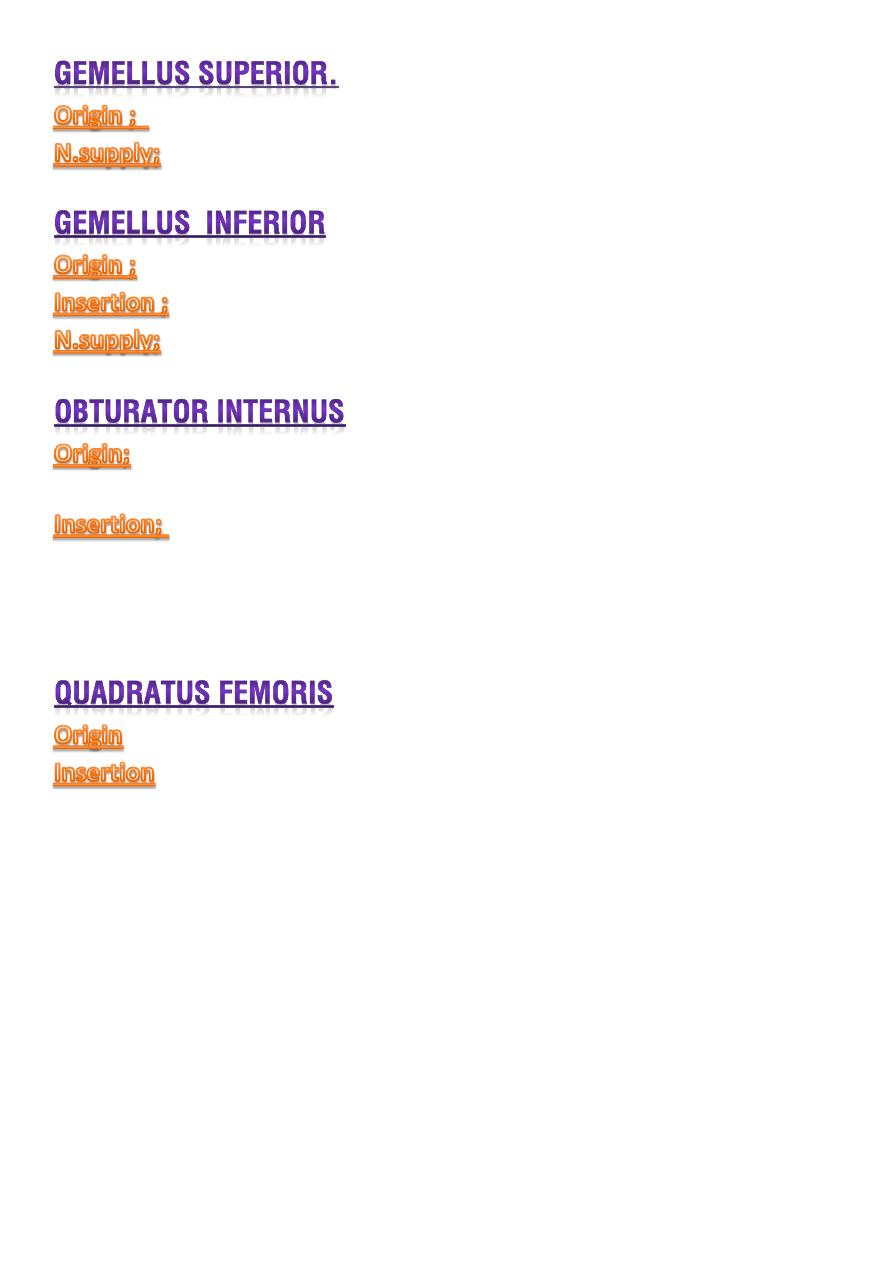
spine of the ischium.
n.to the obturater internus.
upper margin of the ischial tuberosity
with the tendon of the obturater internus.
N.to the quadratus femoris from sacral plexus.
from the pelvic surface of the obturater membrane and the
surrounding bones.
the tendon pass through the lesser sciatic foramen and is
joined by the tendon of sup.& inf.gemelli.The common
tendon is inserted into the upper border of the greater
trochanter.
from the lateral border of the ischial tuberosity.
quadrate tubercle on the intertrochanteric crest of the
femur.
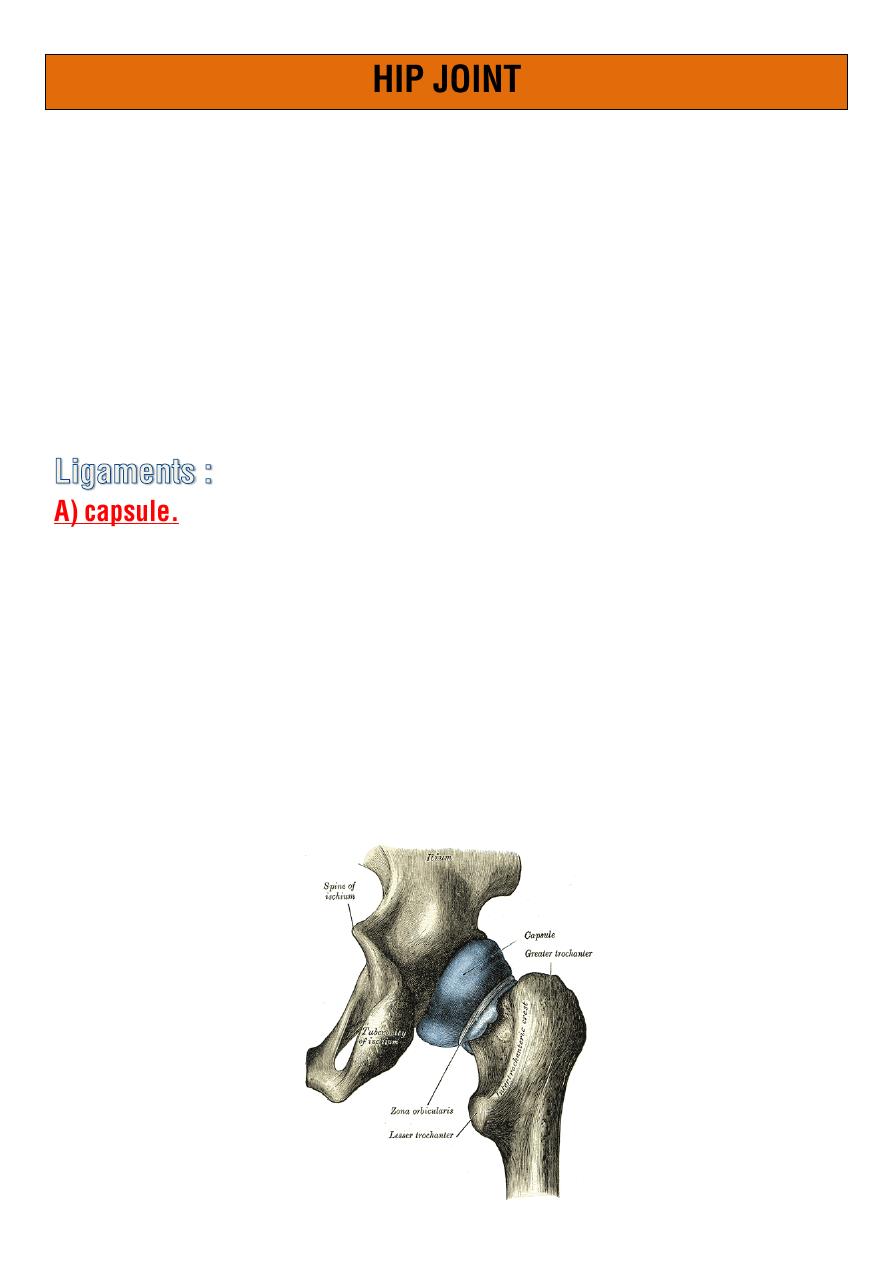
o Is a synovial joint of the ball and socket variety between the
acetabulum of the hip bone and the head of the femur.
o The articular surface of the acetabulum is inverted u shaped being
deficient inferiorly at the acetabular notch.
o The acetabulum is cupped and depened by the acetabular labrum, a
rim of fibrocartilage attached to its borders .
o bridging the acetabular notch is the transverse acetabular ligament.
o strong and dense, attached :
proximally
to the acetabular labrum and the edge of the
notch.
distally
it is attached to the femur along the intertrochanteric
line infront and to the neck 1 cm above the intertrochanteric
crest from behind.
o some of the capsular fibres turn back medially along the neck and
are known as retincula,they carry blood vessels toward the head
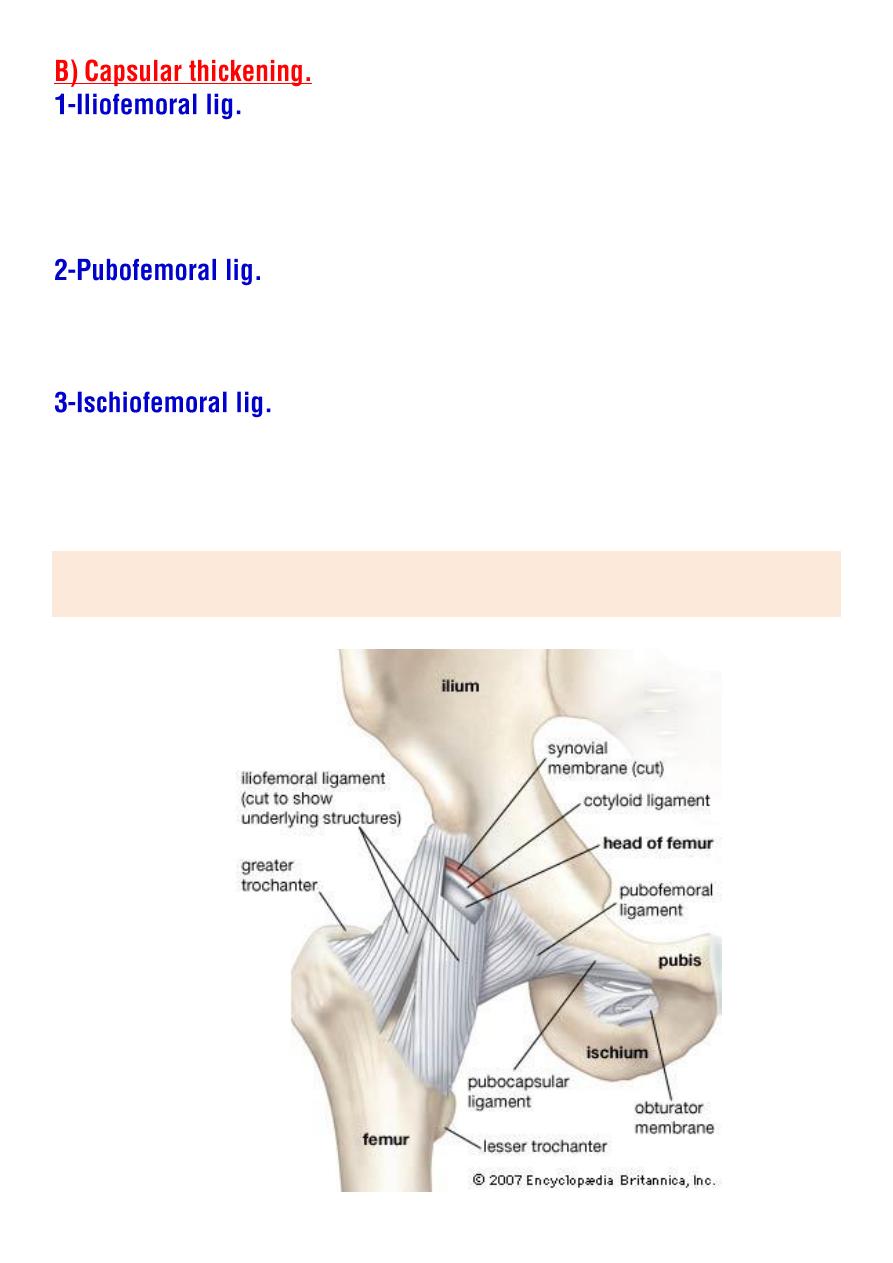
is a strong inverted v shaped attached above to the A.I.I.S. and
bifuricating inferiorly gain attachment to each end of the
intertroghanteric line.
passes from iliopubic eminence to the lower part of the capsule and
under surface of the neck.
passes upward from the acetabular margin to the upper end of the
intertroghanteric line and the adjacent upper surface of the neck.
The three ligaments are spiral in such away as to limit extension at the
joint.
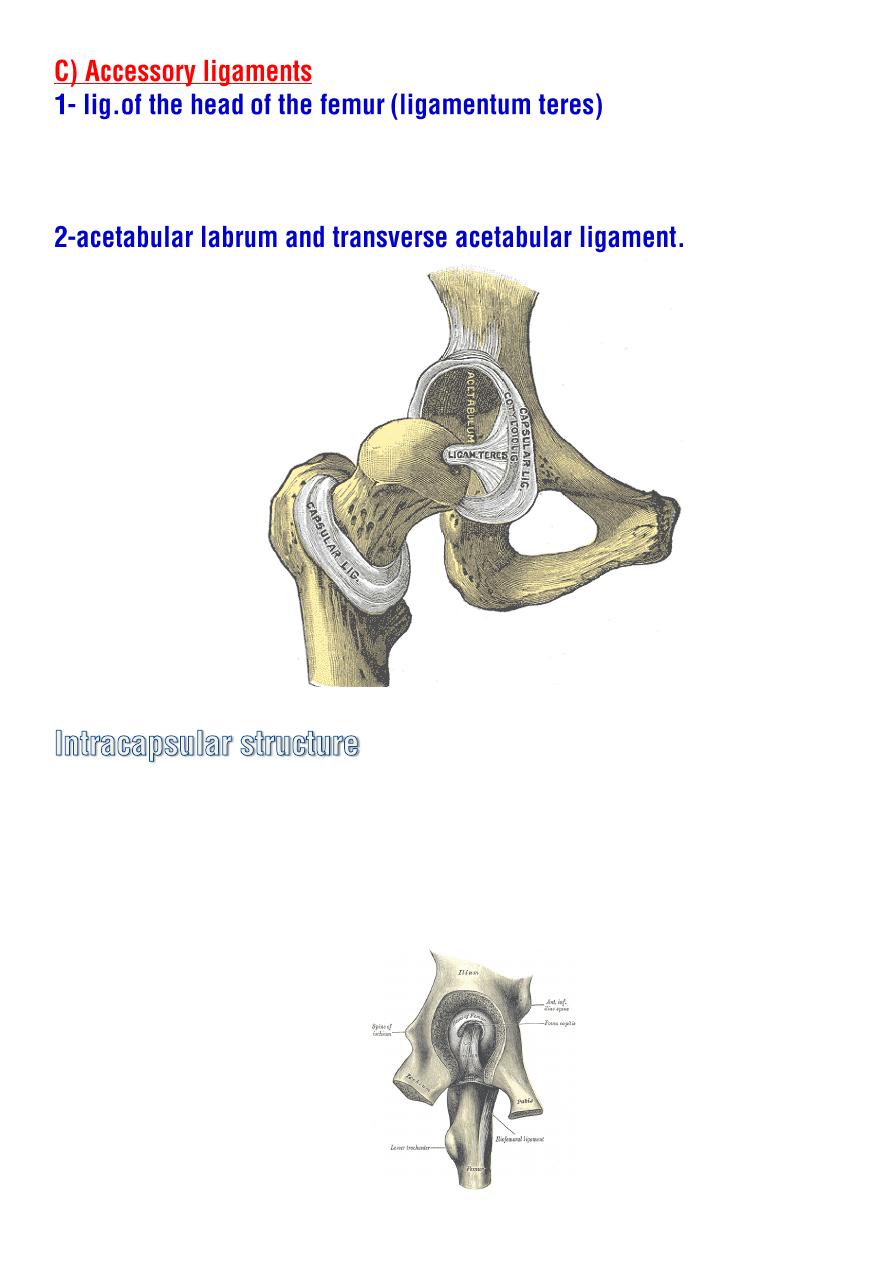
passes from the fovea to the articular notch .it is lax may contain some
vessel of special importance in the child.
o the synovial membrane lines the nonarticular surface of the joint
and ensheath the ligamentum teres.
o The cavity of the joint communicate with the psoas bursa between
the iliofemoraland pubofemoral lig.
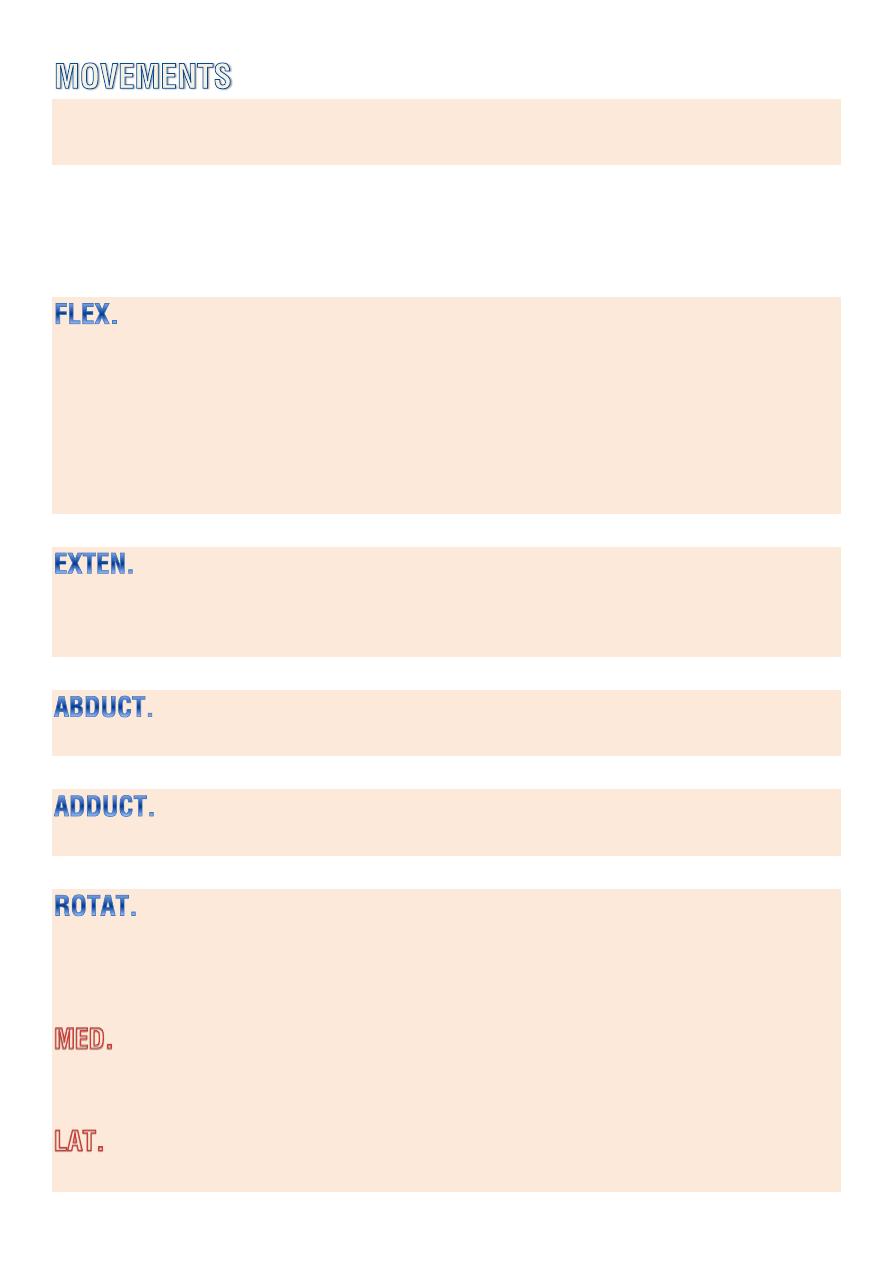
The hip joint is capable of :
flexion , extension , abduction , adduction , circumduction , medial and
lateral rotation.
o In the anatomical position the line of weight passes behind the axis
of the joint and so gravity encourage extension of the joint.
iliopsoas , assisted by tensor fascia lata,rectus femoris , Sartorius ,
pectineus.
the movement is limited to about
90 degree
when the knee is flexed
and is much less when the knee is extended because of
tension in the
hamstring muscles
.
gluteus maximus , assisted by gravity , hamstringand tensor fascia lata.
limited by 3 capsular thickening.
gluteus medius and minimus.
adductor ms. Of the thigh , gracilis and gravity.
Occur around an axis joining the center of the head of the femor to the
intercondylar notch of the femur.
ant fibres of gluteus medius and minimus assisted by the iliopsoas.
Short lateral rotaters assisted by glut.maximus
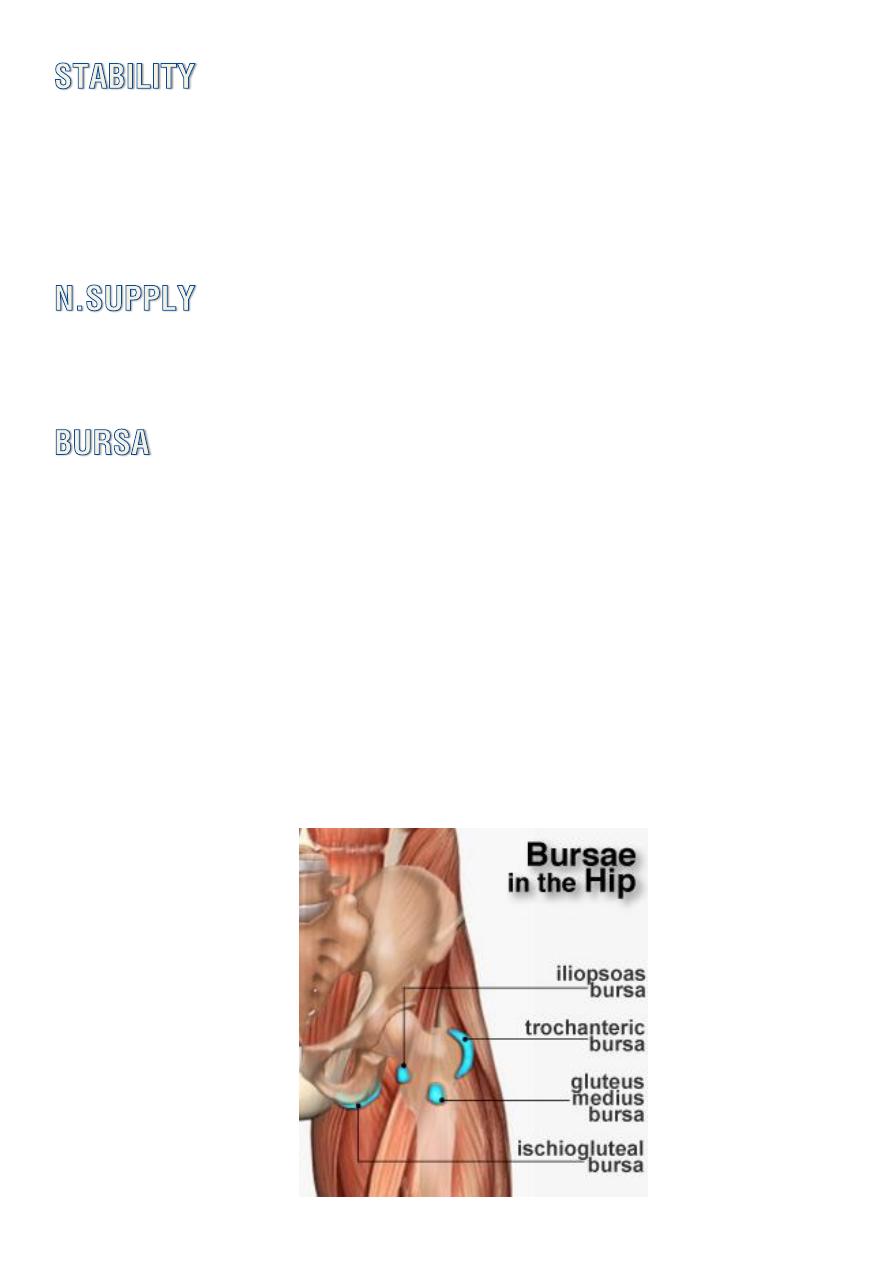
In spite of its great mobility it is very stable because :
1- deep cup of the acetabular clasping the femoral head.
2- strong capsule and its thickening particularly iliofemoral lig.
3- large no. of closely applied short articular muscles.
Branches of femoral,obturater and sciatic n.
o Three associated with glut.maximus
1- between tendon of insertion and the greater trochanter.
2- between tendon of insertion and vast.lateralis.
3- overlying the ischial tuberosity
o Psoas bursa
separate the iliopsoas tendon from the iliac fossa and
supr.pubic ramus.
it may communicate with the cavity of the hip joint between
the iliofemoral and pubofemoral lig.
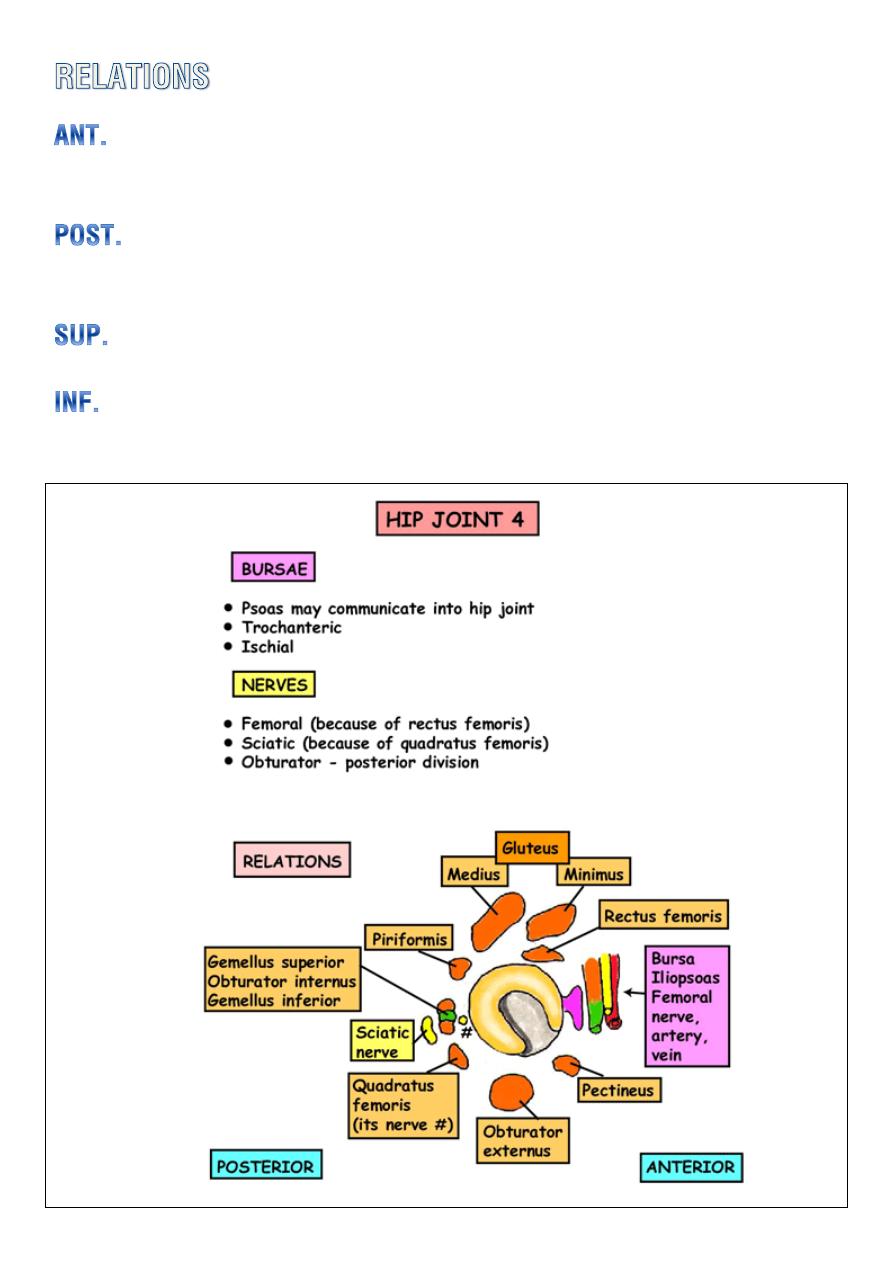
iliopsoas,pectineus separate the joint from the femoral vessels
and nerve.
piriformis,obturater internus,quadratus femoris separate the
joint from the sciatic n. and gluteus maximus.
gluteus minimus and reflected head of rectus femoris
obturator externus.
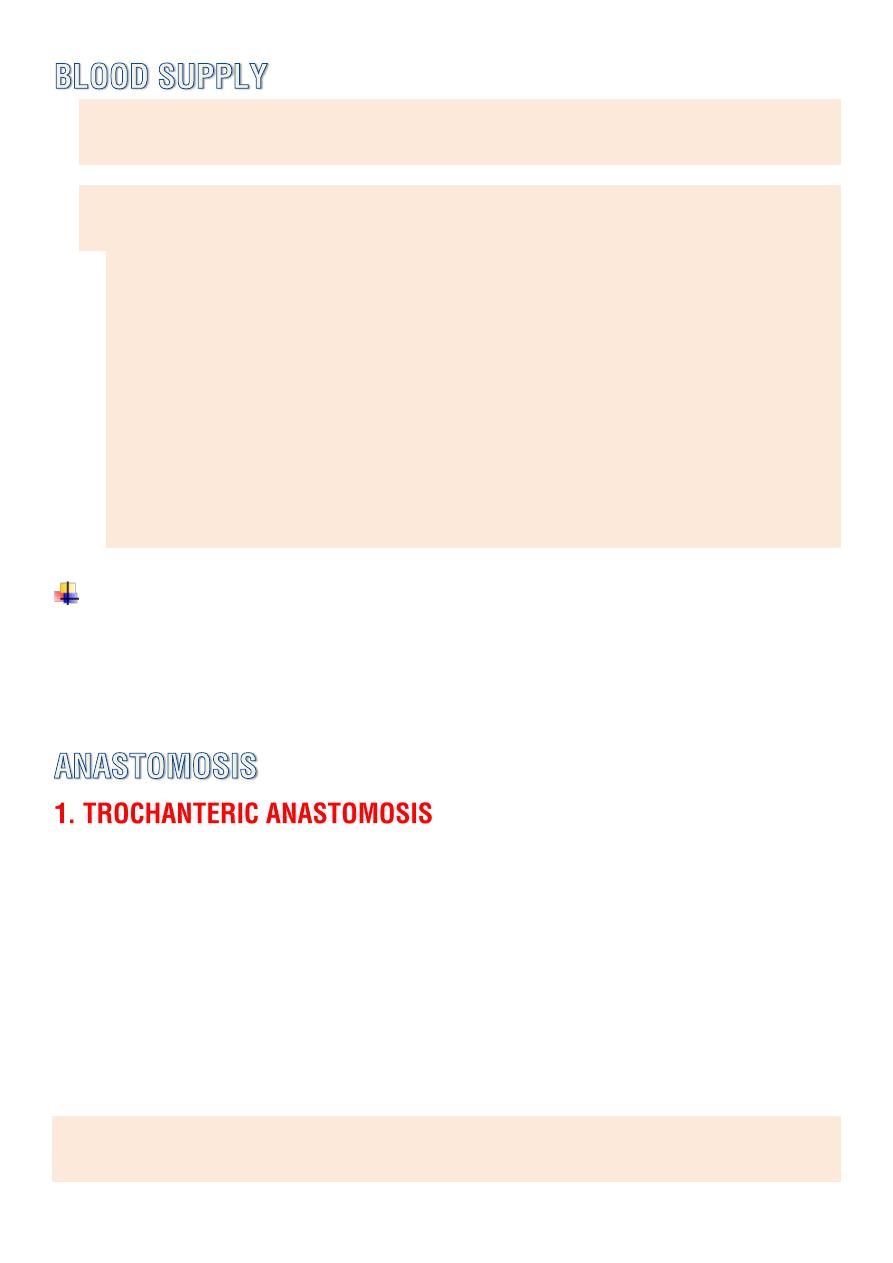
o
The
capsule
and
synovial membrane
are supllied from nearby
vessels.
o
The
head
and
intracapsular part of the neck
receive their blood
supply from two sources.
1-The
ligament of the head
contains an arterial twig from the
obturater artery
,this vessel supplies the head in the young
bone. As age advanced it will supply only thin flake of bone.
2-The
major
part of the head is supplied by
arteries in the
retincula
which bind down the nuterient arteries that pass
chiefly from the
trochanteric anastomosis
along the neck of the
femur.
Fracture of the femoral neck within the capsular attachment
necessarily rupture the
retincular fibers
and the
vessels
causing
avascular necrosis of the head.
This provides the main source of blood supply of the head of the
femur. It lies near the
trochanteric fossa
. It is formed by anastomosis
of :
1- descending branch of sup. gluteal A.
2- ascending branches of both lat. and med. femoral circumflex As.
3- inferior gluteal A.
Branches from the anastomosis pass along the femoral neck beneath
the retincular fibres of the capsule.
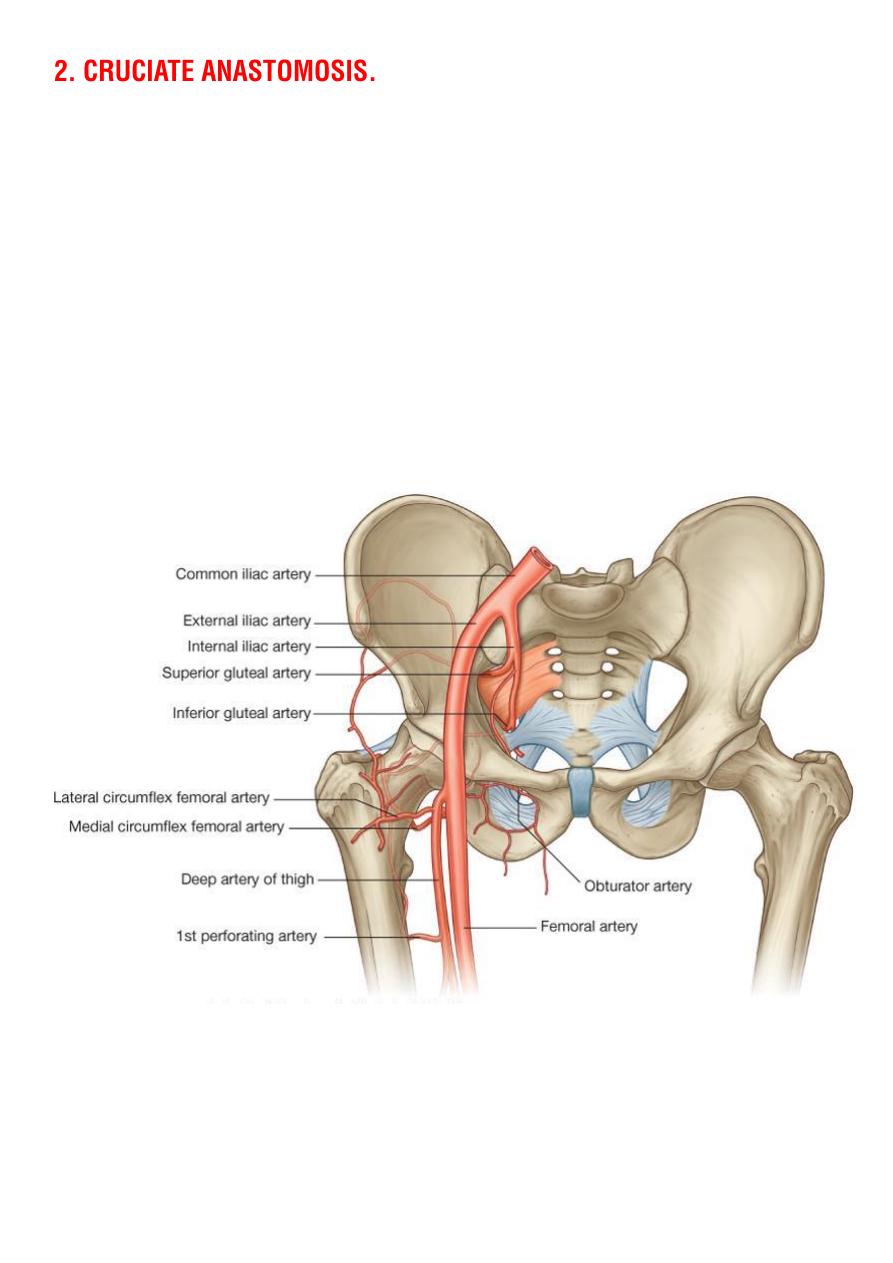
Is situated at the level of the
lesser trochanter
of the femur.
Together with the trochanteric anastomosis provide a connection
between
internal iliac and femoral arteries
It is formed by
anastomosis of :
1- Inf. gluteal A.
2- Transverse branch of medial circumflex A.
3- Lateral femoral circumflex A.
4- The first perforating artery –a branch of the profunda femoris A.
